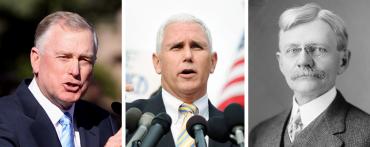
By selecting Mike Pence as his running mate, Donald Trump has once again put an Indiana politician on center stage in a presidential race and the Hoosier State could be producing yet another vice president.
"Indiana is the mother of vice presidents; home of more second-class men than any other state,” said Thomas Marshall. Having been Woodrow Wilson’s understudy, Marshall, who served as governor of Indiana, knew of what he spoke.
While it’s been solidly Republican in most recent presidential contests--though Barack Obama carried it in 2008--Indiana had been a key swing state at the end of the nineteenth and start of the twentieth centuries. Despite that, the Hoosier State has produced only one president over the years: Benjamin Harrison whose house in Indianapolis ranks as one of the more charming and accessible presidential museums. But, when it comes to vice presidents, Indiana has produced something of a bumper crop.
In 1868, Ulysses S. Grant picked Schuyler Colfax, a Republican from Indiana, as his running mate. Colfax was an anti-slavery Republican who rose to become speaker of the House, a good balance to Grant who had never held elected office before winning the White House. But Colfax played his cards badly, insisting to party leaders that Grant would not run for a second term and positioning himself for 1872. When Grant ran again, Colfax was left scrambling and ended up being denied a second term as vice president. When his name surfaced in the Crédit Mobilier affair, Colfax’s political career was ended.
Thomas Hendricks, who served as a congressman, U.S. senator and governor from Indiana, came close to being vice president in 1876 as Samuel Tilden’s running mate. But Tilden lost out in the disputed contest with Rutherford B. Hayes. Hendricks bounced back in 1884 as the understudy to another New York Democrat in Grover Cleveland. Unfortunately, Hendricks did not have long to enjoy the vice presidency. Hendrick was in bad health when he took office in 1885, dying later that year.
After stints as a political reporter, campaign strategist and senator, Indiana Republican Charles Fairbanks was Teddy Roosevelt’s running mate in 1904. Once in office, Roosevelt was often at odds with the conservative Fairbanks and the vice president even tried to rally conservative Republicans against his boss. After failing to win the Republican presidential nod in 1908, Fairbanks tried to get his old job back in 1916, running as Charles Evans Hughes’ understudy against Woodrow Wilson who won a second term.
Wilson also had a vice president from Indiana in Thomas Marshall. First elected governor in 1908, the affable Marshall was known for his wit and good humor, including his memorable “what this country needs is a really good five-cent cigar" which was a popular political line for years. Marshall also used to relate the story of a mother who had two sons, one of whom went to see and the other was vice president--and neither was ever heard from again. Marshall even sent Wilson a book inscribed “from his only vice.” Apparently Marshall’s wit failed to impress Wilson. The two Democrats were often at loggerheads and, when Wilson was incapacitated with a stroke, the vice president was left out of the loop.
Indiana became less critical as the twentieth century went on but it did produce one more vice president in Dan Quayle, a U.S. senator who George H.W. Bush selected as his running mate back in 1988. With his infamous series of gaffes, Quayle became a national punchline but he also helped keep conservatives in line behind Bush. In the 2000 election cycle, Quayle attempted a political comeback and ran for the Republican presidential nomination but he didn’t even get to Iowa as George W. Bush, the son of his former boss, ran him over. Fittingly, there’s a vice presidential museum in Huntington, Quayle’s hometown and State Highway 9 is “the Vice Presidential Highway.”
Of course, Indiana had more than its share of losers as well. While he was based in New York, Republican Wendell Willkie played up his Indiana roots when he took on FDR in 1940. Hoosier State resident William H. English, a businessman who had served in Congress in the 1850s, was Civil War hero Winfield Hancock’s running mate on the Democratic ticket in 1880 which lost to James Garfield and Chester A. Arthur. Indiana Democrat John W. Kern, an attorney who ran for governor in 1900 and 1904 unsuccessfully, was William Jennings Bryan’s understudy in 1908. Kern later led Democrats in the U.S. Senate.
Now it’s Pence’s turn. Whether he will end up as the latest vice president from Indiana or yet another also-ran from the Hoosier State will be determined in November.


